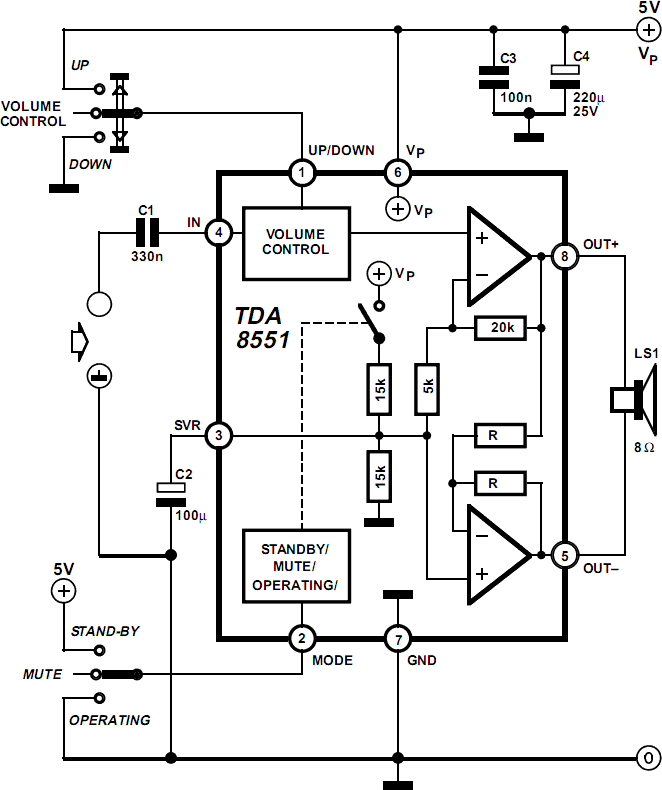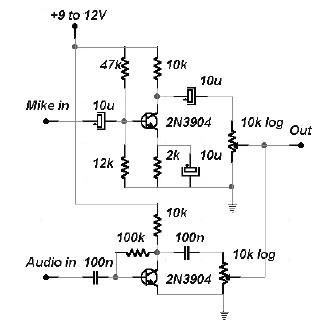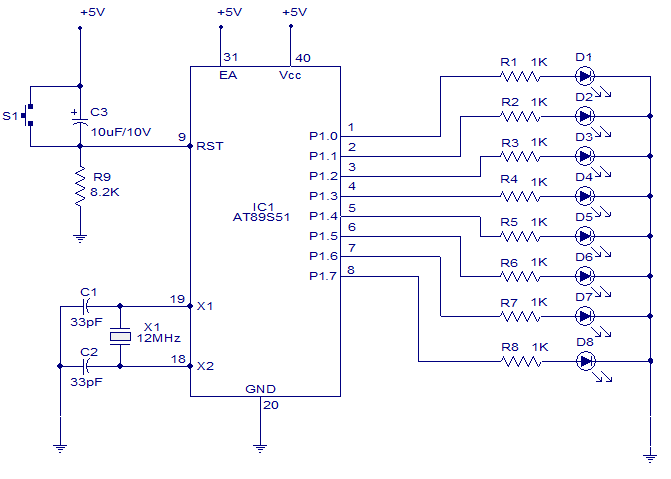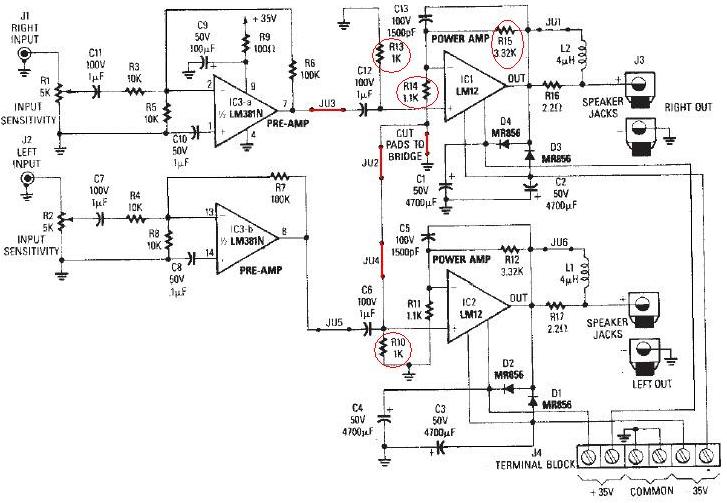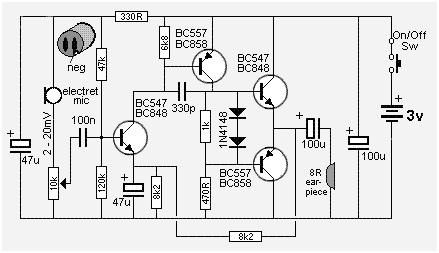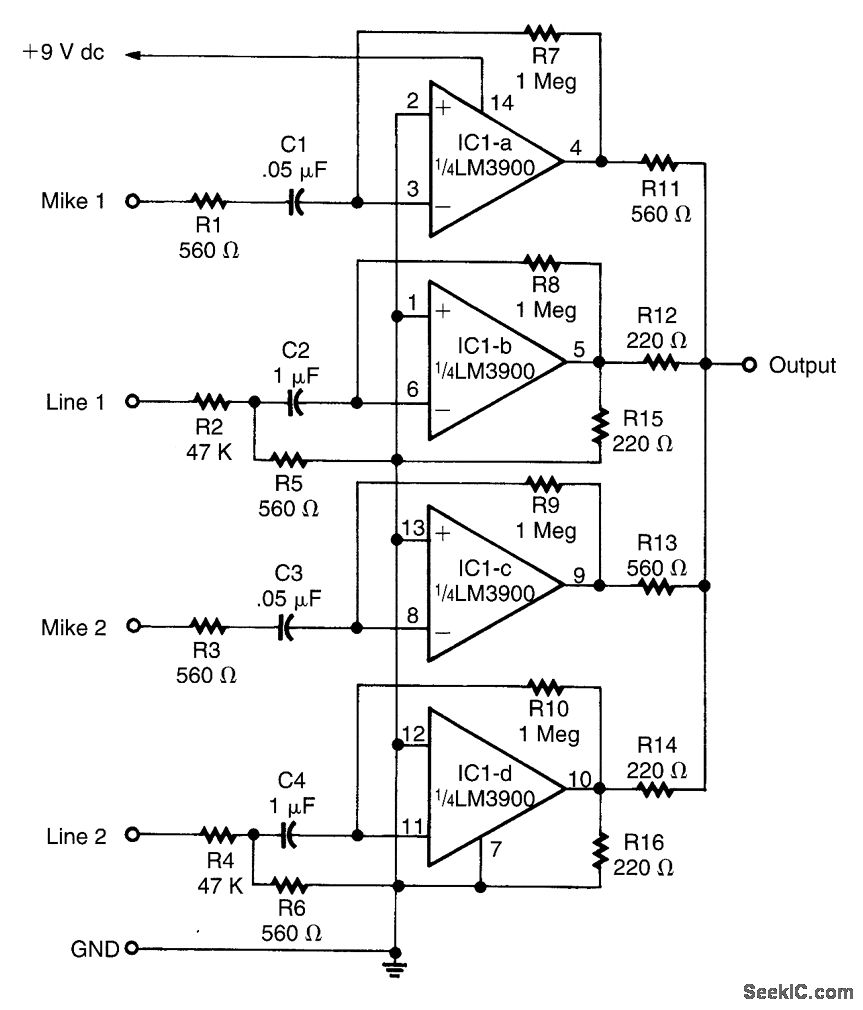
2 channel audio mixer

This two-channel audio mixer utilizes 2N3904 transistors to create two preamplifiers. The first preamplifier is designed for high gain and is suitable for microphone inputs, while the second preamplifier is used to regulate the audio level input. The mixer requires a power supply with an output voltage ranging from 9 to 12 volts. Audio sources can include a CD player, MP3 player, or other audio devices, and a standard dynamic microphone can be used for the microphone input.
The two-channel audio mixer circuit is designed to enhance audio signals by employing two 2N3904 transistors, which serve as preamplifiers. The first preamplifier is optimized for high gain, making it ideal for amplifying low-level signals from dynamic microphones. This is crucial in professional audio applications where clear vocal input is necessary. The second preamplifier is configured to manage the audio level from various sources, allowing for seamless integration of different audio devices, such as CD players and MP3 players.
The circuit operates within a specified voltage range of 9 to 12 volts, which is essential for the proper functioning of the 2N3904 transistors. A regulated power supply is recommended to maintain consistent performance, minimizing distortion and ensuring that the audio output remains clear and undistorted.
Input connections for the mixer are straightforward: the microphone is connected to the first preamplifier, while the audio devices are connected to the second preamplifier. The output of both preamplifiers can be combined using passive mixing techniques, such as resistive summation, to create a single mixed output that can be sent to an amplifier or recording device.
Overall, this two-channel audio mixer is suitable for various applications, including live sound reinforcement, home recording, and audio experimentation. Its simple design and reliance on readily available components make it accessible for hobbyists and professionals alike, while its performance capabilities ensure that it meets the demands of a variety of audio environments.This 2 channels audio mixer is based on the 2n3904 transistors which forms 2 preamplifiers. The first preamplifier of the audio mixer has a high gain and can be used for microphone input, and the second one can be used to control the input of the audio level. This two channel audio mixer require a power supply with the output voltage between 9 to 12 volts. For the audio signal you can use a CD player, mp3 player or other audio device and for the microphone you can use a normal dynamic microphone. 🔗 External reference
The two-channel audio mixer circuit is designed to enhance audio signals by employing two 2N3904 transistors, which serve as preamplifiers. The first preamplifier is optimized for high gain, making it ideal for amplifying low-level signals from dynamic microphones. This is crucial in professional audio applications where clear vocal input is necessary. The second preamplifier is configured to manage the audio level from various sources, allowing for seamless integration of different audio devices, such as CD players and MP3 players.
The circuit operates within a specified voltage range of 9 to 12 volts, which is essential for the proper functioning of the 2N3904 transistors. A regulated power supply is recommended to maintain consistent performance, minimizing distortion and ensuring that the audio output remains clear and undistorted.
Input connections for the mixer are straightforward: the microphone is connected to the first preamplifier, while the audio devices are connected to the second preamplifier. The output of both preamplifiers can be combined using passive mixing techniques, such as resistive summation, to create a single mixed output that can be sent to an amplifier or recording device.
Overall, this two-channel audio mixer is suitable for various applications, including live sound reinforcement, home recording, and audio experimentation. Its simple design and reliance on readily available components make it accessible for hobbyists and professionals alike, while its performance capabilities ensure that it meets the demands of a variety of audio environments.This 2 channels audio mixer is based on the 2n3904 transistors which forms 2 preamplifiers. The first preamplifier of the audio mixer has a high gain and can be used for microphone input, and the second one can be used to control the input of the audio level. This two channel audio mixer require a power supply with the output voltage between 9 to 12 volts. For the audio signal you can use a CD player, mp3 player or other audio device and for the microphone you can use a normal dynamic microphone. 🔗 External reference
